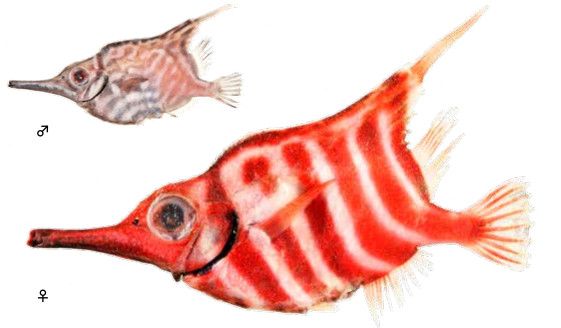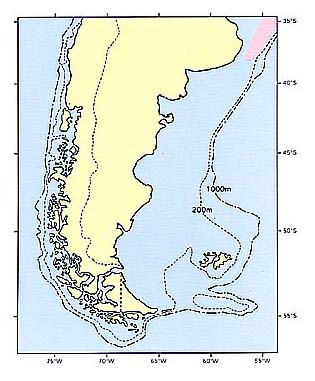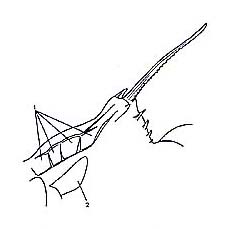サギフエ科
- HOME
- デジタル図鑑
- パタゴニア海域の重要水族
- 硬骨魚綱 トゲウオ目 サギフエ科
サギフエ科(Macrorhamphosidae)

59 ミナミサギフエ(Minami-sagifue)
Notopogon schoteli (Weber, 1910)
Canario, Trompetero (Arg., Urg.); Pez trompeta (Arg.)
特 徴:
背鰭6棘,17軟条,臀鰭18軟条,胸鰭17軟条,腹鰭1棘,5軟条。体長に対する頭長の割合は46.4%,体高は42.9%,眼径は8.8%,両眼間隔は8.1%,吻長は29.8%,胸鰭長は16.6%,尾柄高は7.9%,背鰭第2棘長は29.7%,体は強く側扁し,輪郭は楕円形。吻は管状に延び,先端の口には歯がない。鰓孔は広い。背鰭第2棘は長大で強く,体長の約1/3,その先端は尾鰭後縁を越える。この棘の後縁には約20本の小さな鋸歯がならぶ。背鰭起部は胸鰭起部と尾鰭後端の間のほぼ中央上にある。尾鰭後縁は湾入する。腹鰭は後位で小さく,肛門の直前にある。臀鰭基底は背鰭軟条部基底より長い。鰓耙は小さく,数が多い。側線は体の後方から尾柄にかけて10~11個の小さな孔となっている。鱗は小さく固く,表皮に埋没し,さわるとザラザラする。胸鰭上方から背鰭基底にかけての体側前上方部に骨板が皮下に埋没していて,その隆起縁は体表に現われている。また喉部と腹鰭の腹正中線上に骨質隆起縁がある。体側には斜めに紫青色の6本の帯があり,地色は乳白色,鰓蓋部および眼下域は銀白色。頭部背面と吻は青黒色。各鰭は半透明。
分 布:
ウルガイからアルゼンチン北部の陸棚上。
備 考:
Notopogon属には4種類が知られている(Norman, 1966)。
(稲田伊史)
Material examined:
1 from Argentina (132.8 mm SL), FSFL EM 606.
Description:
D Ⅵ, 17; A 18; P1 17; P2 Ⅰ, 5. HL 46.6% of SL; ED 8.8; BD 42.9; SN 29.8; IO 8.1; CP 7.9.
Body oval and strongly compressed. Direct distance from base of longest dorsal spine to anus less than half of standard length. Snout tube-like, tip of mouth toothless. Gill-opening wide. Second spine of dorsal fin thicker and longest, its entire length 29.7% of SL, its tip exceeding level of posterior caudal margin, its hind margin having about 20 small serrated spines. Origin of dorsal fin situated around midpoint between pectoral fin origin and posterior caudal fin margin. Pelvic fin small and situated just anterior to anus. Base length of anal fin longer than that of soft dorsal. No bristles on parietal. Gill-rakers small, numerous. Lateral line extending from posterior part of body to caudal peduncle, with 10 to 11 small pores. Scales small, tough and roughly surfaced, embeded in skin. Four well-developed bony plates embedded in skin on each side of back, and their margins forming bony ridges, transverse ridges of plates nearly vertical. Midline of abdominal margin between throat and pelvic fin forming bony ridge. Six oblique purplish-blue bands on each side of body, ground color of body silvery white. Gill-cover and subocular region silvery. Upper parts of head and snout dark blue. Each fin semitranspaent.
Distribution:
Outer region of the continental shelf from Uruguay to northern Argentina. Mid- or deep-water.
Remarks:
According to Figueiredo and Menezes (1980), this genus has 7 dorsal spines. Some discrepancies are found between this and other published descriptions; the author followed the generic allocation of Ringueiet and Aramburu (1960). The closely related species, N. fernandezianus, differs from N. schoteli in the number of dorsal fin spines and rays, and in the presence of bristles on the parietal. Four species are recognized for Notopogon (Norman, 1966).
(Tadashi INADA)

Distribution of Notopogon schoteli in Patagonia.

Dorsal part of body. Bony plates (1) and pectoral fin (2).
- 1